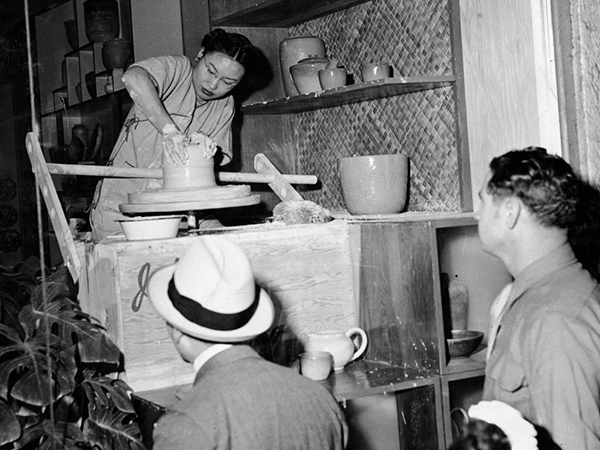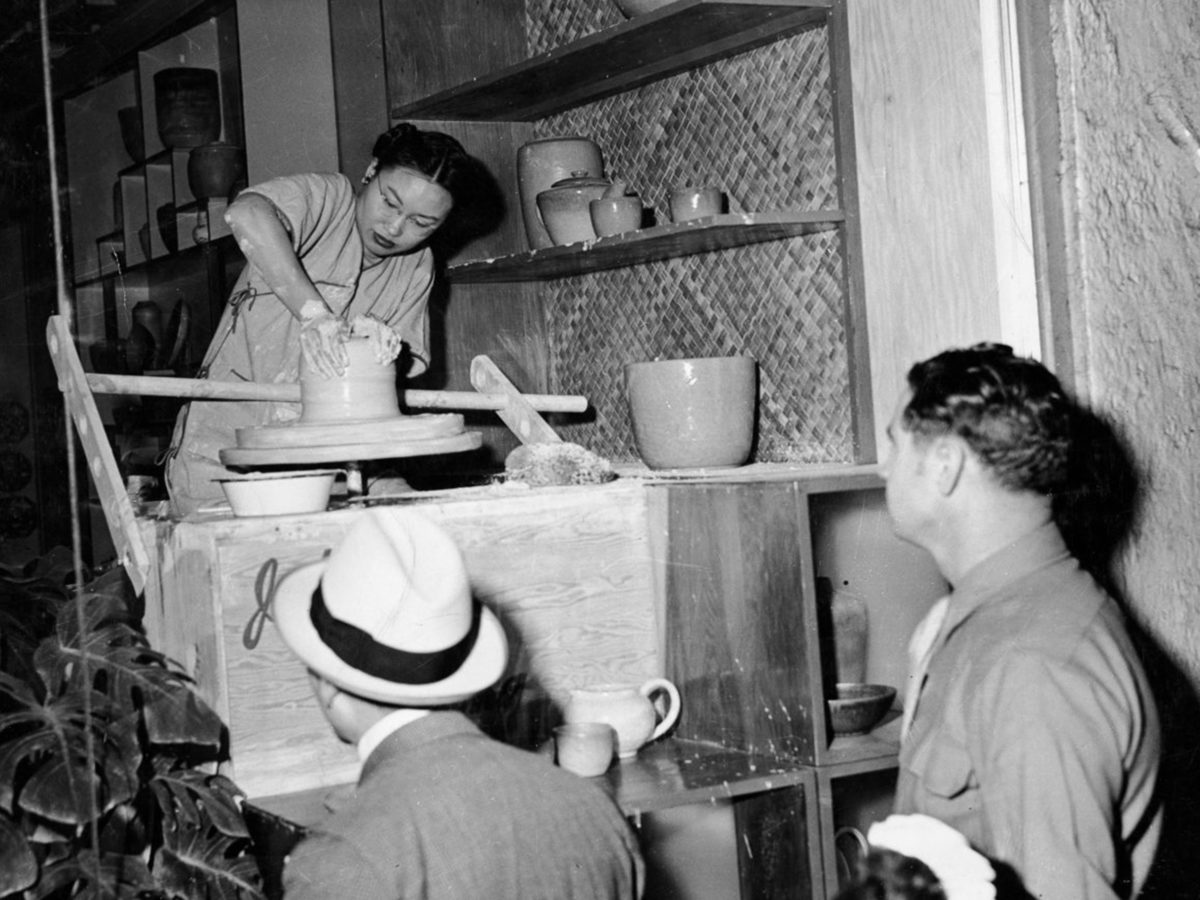Activity
Jade Snow Wong: Drawing Together Her Many Influences
Objective: Students will 1) become familiar with Wong’s artistic style and recognize how an artist can have many influences and sources of inspiration; 2) use compare-contrast skills in discussing artwork from different cultural contexts; and 3) practice online research skills, presentation skills, and working in groups.

Jade Snow Wong
Common Core Standards
Visual Arts 1.0: Processing, Analyzing, and Responding to Sensory Information Through the Language and Skills Unique to the Visual Arts
Visual Arts 3.0: Understanding the Historical Contributions and Cultural Dimensions of the Visual Arts
Visual Arts 4.0: Responding to, Analyzing, and Making Judgments about Works in the Visual Arts
Visual Arts 5.0: Connecting and Applying What is Learned in the Visual Arts to Other Art Forms and Subject Area and to Careers
K-12.SL.1: Engage effectively in a range of collaborative discussions (one-on-one, in groups, and teacher-led) with diverse partners on grade appropriate topics and texts, building on others’ ideas and expressing their own clearly and persuasively.
Materials
Laptops/computers with internet access, projector.
Procedures
Before starting this activity, you might want to visit Jade Snow Wong: Breaking the Mold or complete this Pre-Activity Discussion:
Before showing the students images of Wong’s ceramics, divide the students into small groups, with each group getting one of the quotes below from Wong’s second memoir, “No Chinese Stranger.” If you need to create more than three groups, you can have multiple groups discuss the same quote. (Note that Wong wrote the first part of this memoir in the third person.)
Quotes:
“From the first, the local Chinese were not Jade Snow’s patrons. The thinness and whiteness of porcelains imported from China and ornate decorations which came into vogue during the late Ching Dynasty satisfied their tastes. They could not understand why “silly Americans” paid dollars for a hand-thrown bowl utilizing crude California clays, not much different from the inexpensive peasant ware of China. That the Jade Snow Wong bowl went back to an older tradition of understated beauty was not apparent. They could see only that she wouldn’t apply a dragon or a hundred flowers.” (22)
“To enlarge her production base, she experimented with enamels on copper forms conceived in the fluid shapes of her pottery, layering jewel tones for brilliant effects. They differed from the earth tints of clay and attracted a new clientele. With another kiln and new equipment, she made functional forms, believing that fine things should become part of the user’s everyday life.” (24)
“I am a craftsman who has spent most of her waking hours for the past seven years working with her hands. My materials are clay from the earth or chemicals for the alchemy of glazes. My tools are simple bamboo. My inspiration comes from the weeds in the fields or the colors of a sunset.” (94)
Each group will discuss their given quote and jot answers down for the following questions:
What influences, concerns, and hopes does Wong grapple with in this quote?
What do you think you’ll see in Wong’s art?
Then have the students regather as a large group and share out what they took away from their quote. As a class, brainstorm a list of “what to look for” in Wong’s pieces (to help prime students for analyzing the web images of Wong’s ceramics and enamels). Keep this list on the board or take a picture of it so the students can return to it at the end of the lesson.
Activity:
- Divide students into small groups; each group gets the name of one of Jade Snow Wong’s influences. Depending on the size of your class, you may not use all of the influences listed.
-
Research: In their groups, students will research their assigned artist/movement, to take notes on the following questions:
- Briefly, what was the historical context for this artist/movement? (When did this person live or when did this movement take place?)
- What are three stylistic hallmarks of this artist/movement?
- What is one representative work of art from this artist/movement? Be ready to share an image of this piece.
-
Making Connections: Once they have a general understanding of their assigned influence, the students must then find an image of a Jade Snow Wong work that displays signs of that influence. For a good range of images, they can search the Asian Art Museum’s online collection (for best results, click on the “Advanced Search” tab and enter “Jade Snow Wong” in the “Artist Name” field).
After studying their chosen Jade Snow Wong work, each group should be able to explain the following:
- How does this piece connect to artist/movement that influenced her?
- Where in Wong’s piece do you see similarities to the piece you chose for your assigned artist/movement? Where do you see differences?
- Presentations: After the groups have completed their research, they will share their findings with the class. They will project their two chosen images on the board, give the brief historical context and hallmarks of their assigned influence, and then explain how their chosen Wong artwork connects to it.
-
Wrap-up: Show the students the list of “what to look for in Jade Snow Wong’s pieces” that they brainstormed at the beginning of the lesson. What new terms/phrases would they add to the list now that they’ve learned more about Wong’s art and understand her influences better?
Final Journal Write (making the lesson relevant to the students’ own lives):
Just as Jade Snow Wong was inspired by many artists from different eras and cultures, you have been inspired by artists who have shaped how you express yourself. Which artists (in the visual arts, music, literature, film) have influenced you? Where do you see their influence on how you speak/write/dress/create?
For more lessons based on Jade Snow Wong, visit the artist’s teacher packet.





